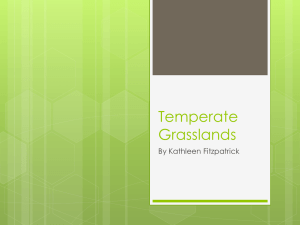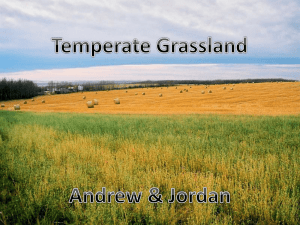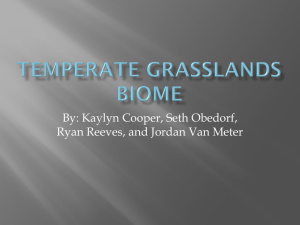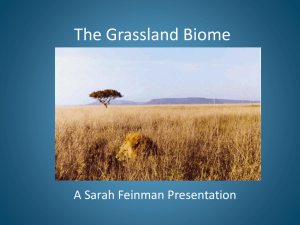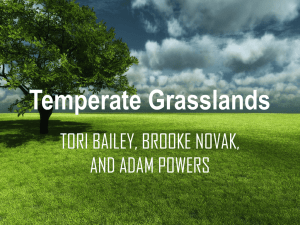The Second Cattlemen`s Meeting in the Natural Grasslands of the
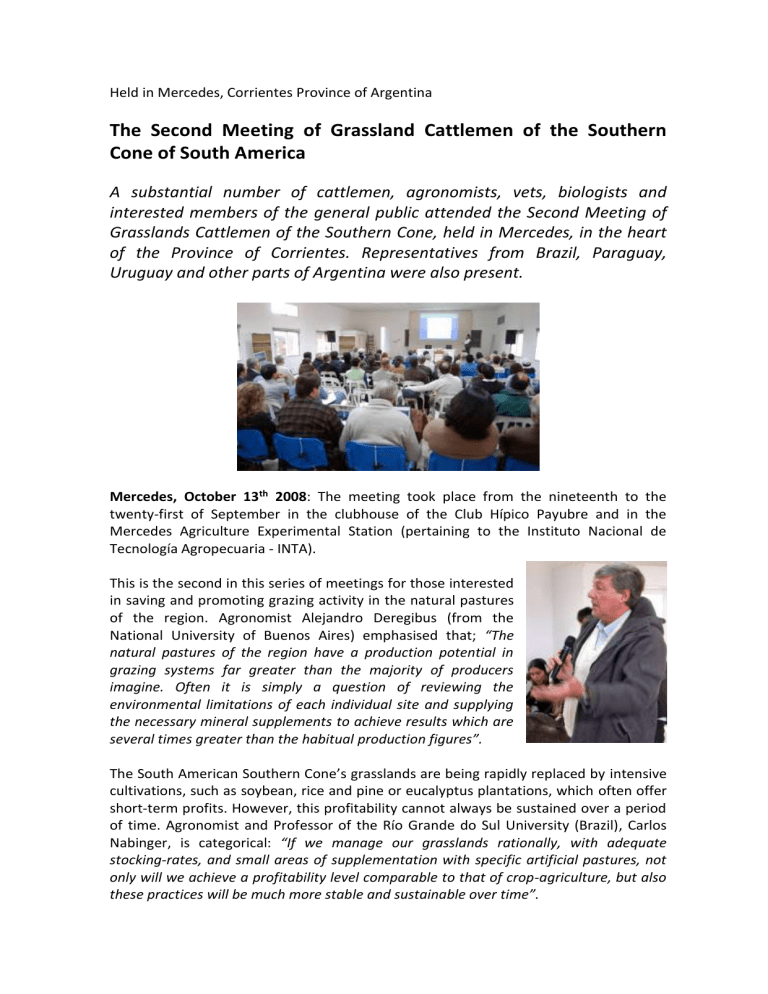
Held in Mercedes, Corrientes Province of Argentina
The Second Meeting of Grassland Cattlemen of the Southern
Cone of South America
A substantial number of cattlemen, agronomists, vets, biologists and interested members of the general public attended the Second Meeting of
Grasslands Cattlemen of the Southern Cone, held in Mercedes, in the heart of the Province of Corrientes. Representatives from Brazil, Paraguay,
Uruguay and other parts of Argentina were also present.
Mercedes, October 13 th 2008: The meeting took place from the nineteenth to the twenty-first of September in the clubhouse of the Club Hípico Payubre and in the
Mercedes Agriculture Experimental Station (pertaining to the Instituto Nacional de
Tecnología Agropecuaria - INTA).
This is the second in this series of meetings for those interested in saving and promoting grazing activity in the natural pastures of the region. Agronomist Alejandro Deregibus (from the
National University of Buenos Aires) emphasised that; “The natural pastures of the region have a production potential in grazing systems far greater than the majority of producers imagine. Often it is simply a question of reviewing the environmental limitations of each individual site and supplying the necessary mineral supplements to achieve results which are
several times greater than the habitual production figures”.
The South American Southern Cone’s grasslands are being rapidly replaced by intensive cultivations, such as soybean, rice and pine or eucalyptus plantations, which often offer short-term profits. However, this profitability cannot always be sustained over a period of time. Agronomist and Professor of the Río Grande do Sul University (Brazil), Carlos
Nabinger, is categorical: “If we manage our grasslands rationally, with adequate stocking-rates, and small areas of supplementation with specific artificial pastures, not only will we achieve a profitability level comparable to that of crop-agriculture, but also these practices will be much more stable and sustainable over time”.
For biologists, whose attention is fixed on the loss of biological diversity in the region’s grasslands (as a result of the replacement of natural grasslands with other systems of production), “free range” grazing systems in natural pastures are compatible with the conservation of the pampas environment. “There are quite a number of species in danger of extinction on a global level, such as the saffron-cowled blackbird and the strange-tailed tyrant which can live perfectly well
in these types of systems,” José Luis Cartes (Paraguay) and Joaquín Aldabe (Uruguay) confirmed.
Some producers from Southern Brazil have been thinking about how to exploit these advantages of their natural grasslands. The agronomist Fernado Adauto, one of the leaders (The Agrarian Federation of Río Grande do Sul), agronomist and Aberdeen Angus breeder in the Bagé area, recalls his experience: “In Brazil forty of us traditional graziers got together. To begin with, we greatly improved our production simply by adjusting our stocking-rates adequately, rotating paddocks and giving small doses of mineral
supplements to cattle in our natural pastures”. Adauto and his group, of which Ricardo
Weiler is a member, have obtained recognition as a “Denomination of Origin”, and they are just a step away from the certification of their products for export. “We were at that stage, when we came to an agreement with BirdLife, Embrapa and the Zoobotanical
Foundation of Río Grande do Sul who helped us to verify the implications of our way of
producing [beef] in terms of the conservation of species,” Weiler commented. He went on to announce that they were next hoping to inform the European markets that their beef products were not only contributing towards preserving their “gaucho” traditions
(something which inspires him considerably), but were also contributing to the preservation of the environment in a scientifically proven fashion.
Lectures on grazing systems and the environment were plentiful during the Mercedes
Meeting. The meeting officially was opened by Hernán Gonzalez Moreno (a local producer and the Corrientes representative in the Sociedad Rural - the chief Argentine
Farmers’ Association), the Director of INTA Mercedes, Dr. Alberto Jomse, the Mayor of
Mercedes, Dr. Jorge Molina and the coordinators of the event Guillermo Stamatti and
Pedro Healy. Apart from the aforementioned, lectures were given by agronomists Rafael
Pizzio and Pilar García (INTA Mercedes), Gustavo Marino (Aves Argentinas), Pablo
Preliasco (Argentine Wildlife Foundation), Angelo Queirolo Aguinaga (Apropampa), biologists Ariel Brunner (BirdLife Switzerland) and Genevieve Thompson (US Audubon
Society, Mississippi River Initiative).
The participants, who got together to form a workshop at the end of the meeting, not only expressed their recognition of the importance of the grazier activity in the Province of Corrientes, considering the extension and the good conservation status of its grasslands, but also the deeply-rooted and well constituted nature of its grazing beefcattle industry.
They also expressed their concern about the current state of crisis of this activity in the entire country, its relatively low production level (as opposed to its potential), the prevailing low value of its products, and the lack of governmental promotion (which usually supports agricultural and forestation activities with greater emphasis) and, as a result of the aforementioned, they called attention to the recession of cattle production as opposed to other activities which are replacing the natural grasslands.
A series of points emerged from the conclusions of this workshop and are as follows;
1.
The beef cattle industry, based on natural grasslands, and, with the contribution of technology which permits an improvement of production and pasture conditions, not only has great economic potential (to date employed only partially) but also encompasses environmental and ecological benefits which should be recognised and valorised.
2.
The need is urgent to take steps to the awarding of greater value to products based on well-managed natural grasslands, whether it be because of the quality of the products (tangible), or the environmental services which are provided by an activity which preserves the environment (intangible)
3.
This should take place within the framework of coherent government policies, which should not only promote productive activities, but also the conservation of goods and environmental services. The demand for a “Government Policy for the
Rural Sector”, which is a current, burning issue in the case of Argentina, (as is
Land Use Planning, pending in several districts of the region) constitutes a good opportunity for the implementation of this initiative.
4.
A greater, clearer diffusion of the existing (but not always available) tools to achieve improved yields (as demonstrated in this meeting’s lectures) through the development of Good Practice Manuals or similar methods of the transference of technology, is considered a matter of urgency
5.
An important issue is the greater and more active involvement of the organisations responsible for the development and transference of technology, non-government organisations, academic institutions and groups of producers of the entire region, in the development of projects which tend towards the application and the following-up of good management practices, improved production and the conservation of the ecological attributes of the grasslands.
6.
Experiences must be promoted including which include practical and verifiable trials, interchanges between producers and the adoption of new technologies in different producers’ groups of each country, and also between countries.
7.
The holding of events like this one are recognised as being adequate spheres of influence to incentivate, facilitate and communicate these types of actions and to nucleate the organisations in question.
8.
Attention is drawn to the necessity of summoning a greater participation of government representatives, officials of the Mercosur Treaty, and political representatives of the four countries in the next Meeting of the Cattlemen of the
Natural Grasslands of the Southern Cone.
Finally, it was decided that the Third Meeting will be held in the city of Asunción del
Paraguay, on the event of the Brangus Breed World Congress scheduled for October
2009.
The organisation of the Second Meeting of the Cattlemen of the Natural Grasslands of the Southern Cone was with the adhesion and support of:


